
Opals Ahorow: Opal Ahorow, Mfiase, Kɔla & Nea Ɛkeka Ho a Wɔahyehyɛ no Yiye!
 Opal te sɛ nea ɛkura nsoromma akuw, nanso so wunim sɛ wiase bi wɔ hɔ a opal ahorow wɔ hɔ a wobetumi anya? Opals a wɔfrɛ no October birthstone , na ɛyɛ abɔde mu anwonwade a ɛyɛ anigye na egu ahorow pii!
Opal te sɛ nea ɛkura nsoromma akuw, nanso so wunim sɛ wiase bi wɔ hɔ a opal ahorow wɔ hɔ a wobetumi anya? Opals a wɔfrɛ no October birthstone , na ɛyɛ abɔde mu anwonwade a ɛyɛ anigye na egu ahorow pii!
Sɛ ɛba opal ahorow ne nea ɛkyerɛ so a, mpɛn pii no, opal ahorow no yɛ anidaso ne nea ɛho nni asɛm ho sɛnkyerɛnne, nanso opal nkyerɛase betumi ayɛ soronko a egyina opal su no so.
Enti, opal ahorow bɛn na ɛwɔ hɔ?
Ɛnnɛ, yɛde mfonini ahorow a wɔatew mu sɛnea ne fã, mfiase, ne kɔla bɛkata opal ahorow nyinaa so. Ansa na yɛbɛhyɛ aseɛ no, momma yɛnkyekyɛ sɛdeɛ wɔkyekyɛ opals mu.
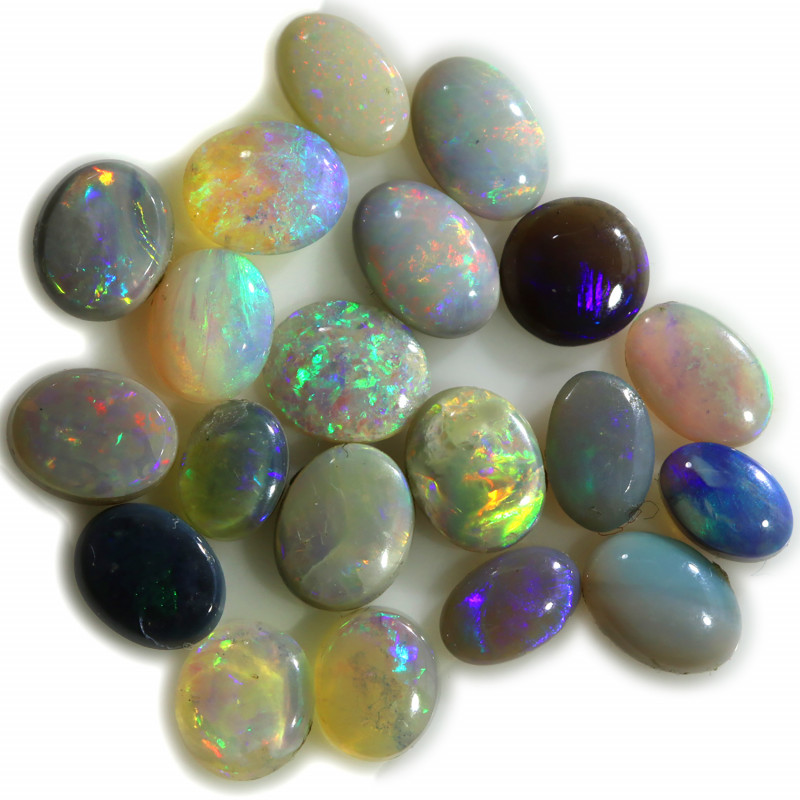
Dɛn Ne Opal Ahorow?
Opal ahorow ɔhaha pii wɔ wiase nyinaa, nanso nsonsonoe a edi kan a ɛsɛ sɛ wohu ne nea abu so ne opal ahorow a ɛsom bo . Opal a ɛsom bo da kɔla a ɛyɛ iridescent adi , bere a opal a wɔtaa de di dwuma no nkyerɛ saa.
Ɔkwan titiriw a wɔfa so kyekyɛ opals mu ne nipadua kɔla. Mfiridwuma mu asɛmfua ne nipadua nne, ɛwom sɛ wɔde “base tone” anaa “background color” nso di dwuma de.
Wɔ opal a ɛsom bo mu no, nipadua no nne yɛ sum anaa hann a ɛwɔ ɔbo no akyi no. Nipadua nne a ɛwɔ opal a wɔtaa yɛ mu no gyina ɔbo no kɔla nyinaa so ara kwa.
Akuw afoforo bi ne opal no fibea, nea ɛka ho, ne sɛnea wɔhyehyɛe . Ansa na yɛbɛkɔ wɔn mu no, dɛn ne opals ahorow 3 a nnipa dodow no ara tɔ?
Opal Ahorow a Agye Din Sen Biara
Ɛmfa ho sɛ opal ahorow ahorow dɔɔso no, opal ahorow abiɛsa na edi kan: opal fitaa/hann, opal a ɛyɛ fitaa/tuntum, ne opal tuntum.

Opal fitaa/Hare a Ɛyɛ Hann
Opal a ɛyɛ hare anaa fitaa kyerɛ opal biara a ɛwɔ nipadua nne N7-N9 na ebetumi ayɛ nea abu so anaasɛ ɛsom bo. Opal a ɛyɛ hare no fi nea enni kɔla so kosi fitaa a ɛyɛ hann so, bere a opal fitaa no wɔ nipadua fitaa kosi fitaa a ɛyɛ mmerɛw. Saa opal ahorow yi betumi ayɛ nea ɛda adi kosi nea ɛnyɛ nea ɛda adi fã, nanso dodow no ara wɔ nne a ɛte sɛ nufusu.
Fitaa ne opal kɔla a abu so sen biara ne opal a ɛsom bo a ɛdɔɔso sen biara. Australia Coober Pedy a wotu no anya din “wiase opal ahenkurow” esiane opal fitaa a ɛsom bo pii a ɛwɔ hɔ nti.

Opal a ɛyɛ fitaa/Dark
Opal a ɛyɛ fitaa anaa tuntum wɔ fitaa ne tuntum ntam, wɔ N5-N6 nipadua nne ahorow mu. Wɔsan frɛ no “semi-black opals,” saa opals a wɔtaa yɛ anaasɛ ɛsom bo yi wɔ nipadua a ɛyɛ fitaa a ɛyɛ mfinimfini a ɛnyɛ tuntum sɛnea ɛbɛyɛ a ɛbɛyɛ opal tuntum. Opal tuntum dodow no ara fi Lightning Ridge anaa Mintabie, Australia. Saa ɔkwan yi ntaa mma te sɛ opal fitaa nanso ɛkyerɛ kɔla a wɔde di agoru a ɛhyerɛn.
Sɛ yɛreka opal tuntum ho asɛm a, dɛn ne opal a ɛho yɛ na sen biara?
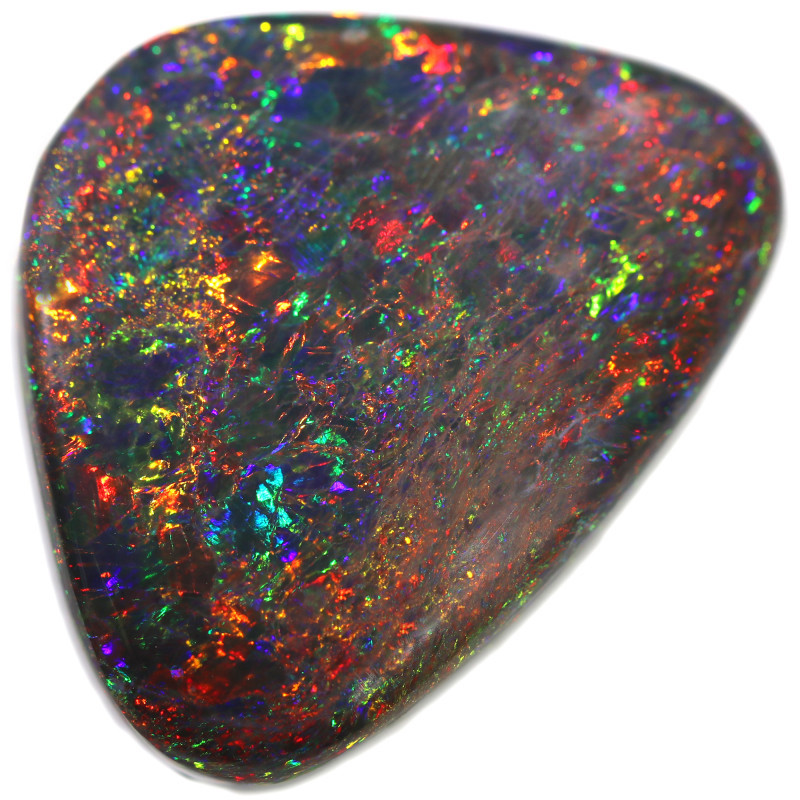
Opal a ɛyɛ tuntum
Black opal yɛ opal ahorow a ɛho yɛ na sen biara, a wɔde nipadua a ɛyɛ tuntum a ɛyɛ tuntum kosi tuntum a efi N1-N4 na ɛkyerɛkyerɛ mu. Saa opals yi betumi ayɛ opal tuntum a ɛyɛ mmerɛw anaasɛ opaque, ɛwom sɛ opal tuntum a wɔtaa de di dwuma ne nea ɛsom bo nyinaa wɔ hɔ de.
Bere a ɛntaa nsi no, opal tuntum a ɛyɛ aboɔden abo dodow no ara fi Lightning Ridge, Australia. Black a ɛsom bo opal wɔ play-of-color a ɛhyerɛn sen opal biara. Kɔla afoforo bɛn na opal ahorow na ɛba?
Opals Sɛnea Nipadua Kɔla Teɛ
Wɔ fitaa, fitaa, ne tuntum akyi no, wubetumi ahu opals a ɛwɔ pink, purple (morado), bruu, ahabammono, enni kɔla, ne ogya kɔla nso. Momma yɛnhwehwɛ emu biara mu!

Opal a ɛyɛ pink
Pink opal yɛ opal a wɔtaa de di dwuma a ɛyɛ pink a ɛyɛ mmerɛw kosi bubblegum, ɛwom sɛ ebia kɔla afoforo te sɛ fitaa, kɔkɔɔ, peach, lavender, ne tuntum nso bɛda adi de. Saa opal su yi taa nya nneɛma a wɔde ka ho a ɛma ɛyɛ sum a ɛyɛ nsensanee anaa kɔla mmeae.
Pink opals fi Australia, Mexico, ne USA, nanso Peru na ɛdɔɔso sen biara. Perufo pink opal wɔ ɛnne a ɛte sɛ nufusu ne kɔla a ɛyɛ pefee na ɛyɛ pɛ, titiriw “Andean opal pink.”
Australia Atɔe Fam opals a ɛyɛ pink no yɛ opalized radiolarite ankasa na ɛtaa de ka ho kɛse (a ɛkyerɛ sɛ ɛwɔ aboɔden abo afoforo anaa nneɛma a asɛe kakraa bi), na ɛma ɛyɛ fitaa, bruu, anaa tuntum.
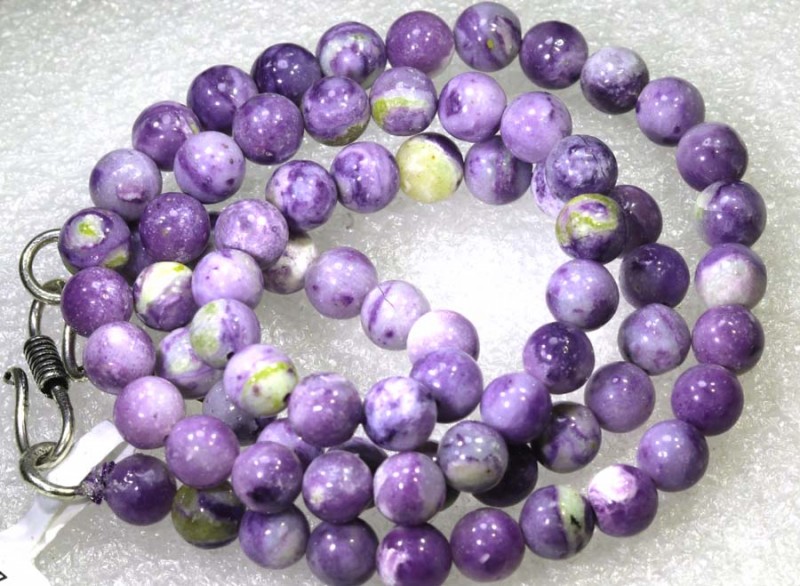
Morado Opal na ɔkyerɛwee
Morado opal a wɔsan frɛ no “purple opal” anaa “Opal Royale” no yɛ opal a ɛyɛ kɔkɔɔ a wɔtaa de di dwuma wɔ Mexico. Kɔla ahorow no fi lavender kosi violet, na mpɛn pii no ɛyɛ nufusu ne ɛnne a ɛnyɛ hann. Kɔla kɔkɔɔ nso pue wɔ Tiffany opal , opal fluorite kuw bi a efi Utah, U.S.A., a fluorine mframa a wɔde kɔla yɛ kɔkɔɔ no mu.

Blue Opals a ɛyɛ bruu
Blue opals betumi ayɛ nea abu so anaasɛ ɛsom bo, efi teal a emu dɔ so kosi wim bruu a ɛyɛ mmerɛw so. Peru wɔ abusuabɔ kɛse ne saa ahorow yi, na “blue opal” taa kyerɛ Perufo bruu opal a wɔtaa de di dwuma. Peru nso yɛ opal bruu a ɛsom bo, na abo bi wɔ kɔla a wɔde di agoru wɔ mmeae nketewa.
Brazil ka Peru ho ma wɔyɛ opal bruu-ahabammono a wɔntaa nhu a wɔfrɛ no Paraiba opal. Opal bruu afoforo a wotu wɔ Slovakia, Indonesia, ne USA, a Oregon Owyhee opal bruu a ɛyɛ pastel ka ho.
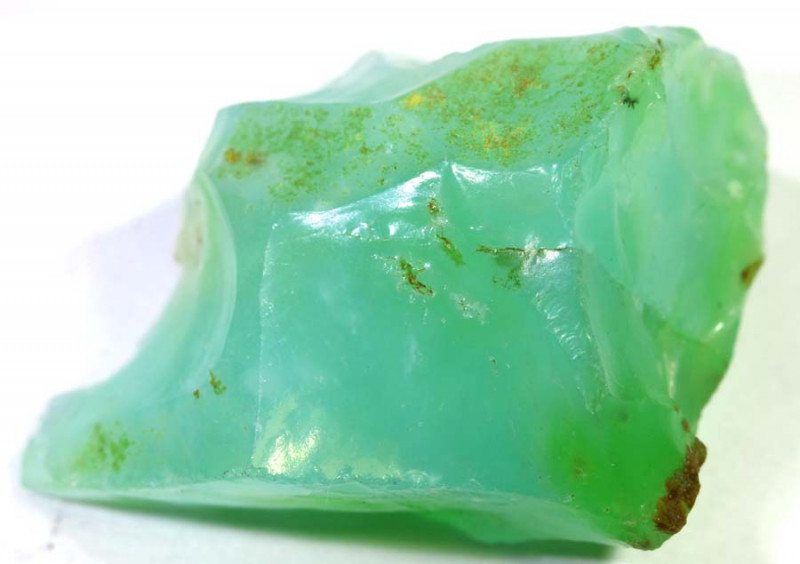
Green Opals a ɛyɛ ahabammono
Opal biako a wɔtaa hu wɔ wiase nyinaa ne green opal , a wohu no wɔ emerald, kɔkɔɔ-ahabammono, anaa jade a wɔayɛ no mum a ɛyɛ nwonwa mu. Wohu wɔ nsasepɔn asia so, na atopae a ɛda nsow sen biara ne Australia, Brazil, Peru, Mexico, ne USA.
Abɔde mu opalite yɛ opal foforo a ɛyɛ ahabammono a wɔtaa yɛ, ɛwom sɛ ɛda kɔla kɔkɔɔ nso adi de. Opalite taa yɛ nsɔe-ahabammono a dendritic tuntum ka ho na ebetumi ada chatoyancy (ɔkraman aniwa nkɛntɛnso adi.) Nhwɛso dodow no ara fi Afrika, nanso Ethiopia ɔkraman aniwa opalite taa yɛ ɛwo anaa kɔkɔɔ.
Opal a ɛyɛ ahabammono foforo biako ne Tanzania prase opal . Nikel wɔ saa ahorow yi mu, na ɛma ɔbo no yɛ neon teal kɔla a ɛhyerɛn. Prase opals yɛ nea ɛyɛ hann kosi nea ɛda adi, na ebinom frɛ no “African jade.”
Nea edi hɔ no, kɔla bɛn na opal som bo sen biara? Ɛno bɛyɛ opal kɔkɔɔ, a ɛba sɛ ɛno nso ne ogya opal kɔla a ɛsom bo sen biara.
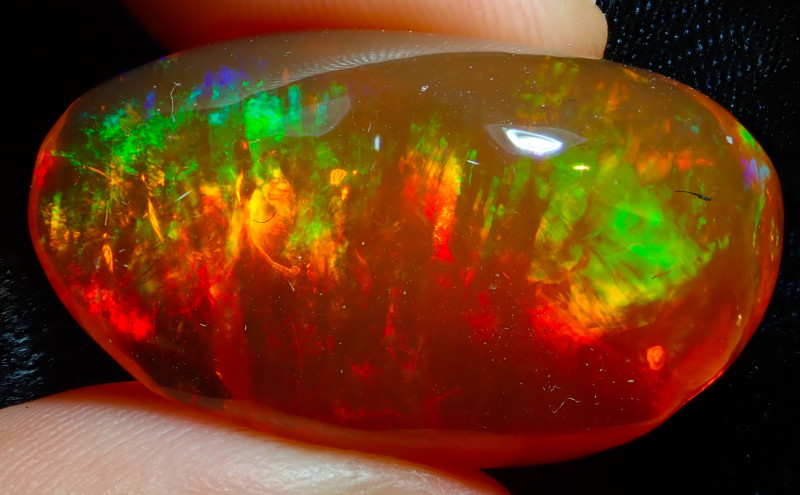
Ogya Opal
So w’ani gye ogya a wɔde hwɛ ade ho? Wubehu saa pɛpɛɛpɛ wɔ ogya opals mu. Ogya opals wɔ nipadua kɔla kɔkɔɔ, borɔdɔma, kɔkɔɔ, ne bruu na ebetumi abu so anaasɛ ɛsom bo. Esiane sɛ wofi Mexico nti, wɔtaa frɛ saa abo yi Mexico ogya opal, ɛwom sɛ efi Australia ne Ethiopia nso de.
Ogya opal ahorow no yɛ soronko wɔ opal dodow no ara ho wɔ sɛnea ɛyɛ hann kosi nea ɛda adi (ɛnyɛ nea ɛyɛ hann) na ɛyɛ ogya mmepɔw mu. Mexico ogya opal dodow no ara yɛ opal a wɔtaa de di dwuma, nanso Ethiopia yɛ ogya opal a ɛsom bo a neon violet ne kɔla ahabammono a ɛhyerɛn wom.

Opal a enni kɔla
Wɔ nyankontɔn no akyi no, yɛwɔ opal ahorow a enni kɔla. Bere a ebia wonni kɔla a wohu wɔ opal ahorow a yɛaka ho asɛm wɔ atifi hɔ no mu no, emu biara wɔ su soronko.
Crystal Opal : Opal biara a ɛsom bo a enni kɔla na ɛyɛ mmerɛw, a nufusu biara nni mu na N7-N8 nni nipadua no nne nsenia so.
Jelly Opal /Water Opal : Opals a ɛsom bo a ɛyɛ mmerɛw, enni kɔla a ɛyɛ tuntum kakra sen crystal opals na ɛte sɛ gelatinous, ɛtɔ mmere bi a ɛwɔ mu play-of-color ne bruu anaa sika kɔkɔɔ hyerɛn.
Contraluz Opal : Wɔakyerɛ ase afi Spania kasa mu sɛ “a ɛko tia hann,” opal a ɛsom bo a enni kɔla kyerɛ kɔla a wɔde di agoru a ɛsensɛn opal no mu bere a wufi akyi hyerɛn ɔbo no.
Sɛ yɛkɔ ɔfa a edi hɔ no mu a, yɛwɔ opal ahorow a wɔakyerɛkyerɛ mu denam nneɛma afoforo a wɔde hyehyɛ so.
Opal Nneɛma a Wɔde Ka Ho & Nneɛma Ahorow
Opal dodow no ara nam akwan a ɛte saa ara so na ɛba, nanso sɛ opal ne aboɔden abo ne nneɛma nketenkete a ɛbɛn no di nkitaho bere a ɛreyɛ no a, ebetumi ayɛ opal foforo koraa. Ebia opal ne nneɛma afoforo bɛka abom wɔ akyi, na opal no anyin atwa aboɔden abo foforo ho ahyia, anaasɛ emu, na nneɛma a ɛka ho no akɔhyɛ opal no mu.
Nneɛma a wɔde ka ho no ka nneɛma biara a wɔakyere wɔ ɔbo a ɛsom bo mu bere a ɔbo no reyɛ no ho. Bere a wɔfrɛ nneɛma dodow no ara a ɛwɔ ɔbo bi so no “nkekae” no, ɛtɔ mmere bi a nneɛma a ɛka ho no tumi du ɔbo no ani.
Sɛ woresusuw opal ko a eye sen biara ho a, nnipa pii bɛka sɛ mineral-combo opal ahorow a edi kan wɔ yɛn din mu: boulder opal!

Ɔbotan a wɔfrɛ no Opal
Boulder opal yɛ opal ne abotan a ɛsom bo a wɔaka abom, a mpɛn pii no ɛyɛ dade anaa anhweatam, ɛwom sɛ ebinom kura afifide anaa nnua a wɔatutu fam ahu sen abotan de.
Opal a ɛsom bo no ba sɛ nsensanee ne/anaasɛ nhama a ɛyɛ tratraa a ɔbotan a ɛgye no abata ho anaasɛ atwa ho ahyia. Eyi ba bere a opal silica nsu a wɔadi kan ayɛ no kɔ ɔbotan no mu mpaapaemu mu ansa na opal no ayɛ den no.
Abotan so opal fibea a edi kan ne Queensland, Australia, na saa beae yi da so ara yɛ beae a ɛdɔɔso. Mmeae afoforo a abotan so opal wɔ ne Brazil ne Canada.
Boulder opals wɔ subtypes kakraa bi:
Boulder Opal Wood Fossil : Wɔsan frɛ no fossil wood replacement opal, saa ahorow yi kura nnua a wɔayɛ no opalized a ɛbata ɔbotan a ɛgye no ho.
Andamooka Boulder Opal : Wotu wɔ Andamooka, Australia, na saa opal ahorow a wɔntaa nhu yi wɔ abotan a wɔde quartzite ayɛ na ɛtɔ mmere bi a wɔfrɛ no “mmea a wɔayɛ wɔn mfonini.”
Opal Nut : Wohu wɔ Australia Yowah anaa Koroit opal mfuw mu, na opal nnua yɛ abotan a ɛyɛ kurukuruwa a ɛte sɛ dua mu nnua na ɛwɔ nhama a ɛda nsow. Mpɛn pii no, abotan a wɔfrɛ no opal a efi saa mfuw yi mu no wɔ dade abo a ɛyɛ chocolate bruu akyi, bere a mmeae afoforo a wotu abo no yɛ abo a ɛwɔ akyi a ɛyɛ bruu a ɛyɛ hare.
Boulder Pipe Crystal Opal : Saa ahorow yi kura crystal opal a wɔayɛ wɔ cylinders a ɛyɛ tokuru anaa tubular mu wɔ ɔbotan a ɛgye ahɔho no mu.
Cantera Opal : Saa su yi yɛ ogya opal anaa opal a ɛsom bo a ɛwɔ pink rhyolite mu.
Boulder opals nso betumi aba sɛ boulder matrix opals, subtype a ɛne yɛn ahorow a edi hɔ no fra: matrix opal!
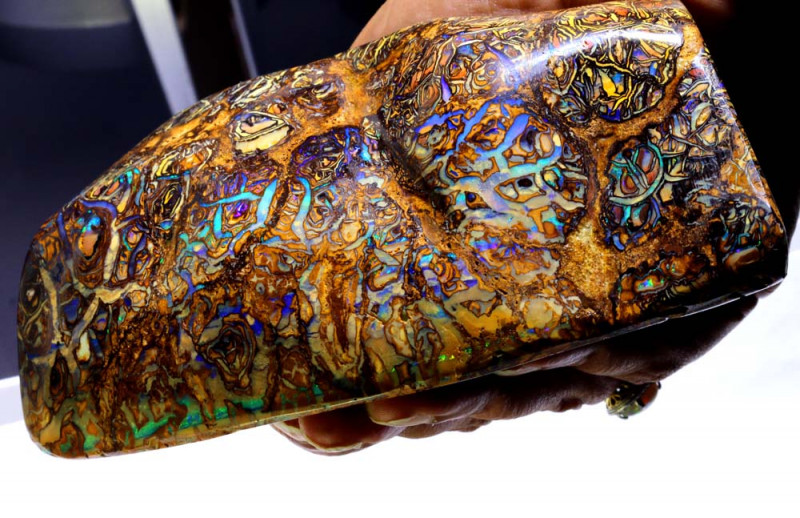
Matrix Opal na ɛyɛ adwuma
Te sɛ boulder opal no, matrix opal kura opal a ɛsom bo a wɔde ne ɔbotan a ɛgye no aka ho. Nanso wɔ matrix opal mu no, opal a ɛsom bo no hyɛ ntokuru anaa ntini a ɛda ɔbotan a ɛgye no no nnua ntam ma, na ɛma kɔla a ɛyɛ pɛ kɛse ba ɔbo no nyinaa mu sen sɛ ɛbɛkɔ afã horow a ɛsono emu biara.
Matrix opal fi Mexico, Honduras, ne Australia. Wɔ Australia no, Andamooka matrix opal yɛ porous, enti ɛnyɛ den (na mpɛn pii no) wɔde nnuru bɛyɛ ho adwuma na ama ne kɔla atu mpɔn. Honduras yɛ matrix opal titiriw na wɔn opaque ahorow no taa nya ɔbotan a ɛyɛ tumm a ɛyɛ ahɔho a opal a ɛyɛ hyew ayɛ ho nsensanee.
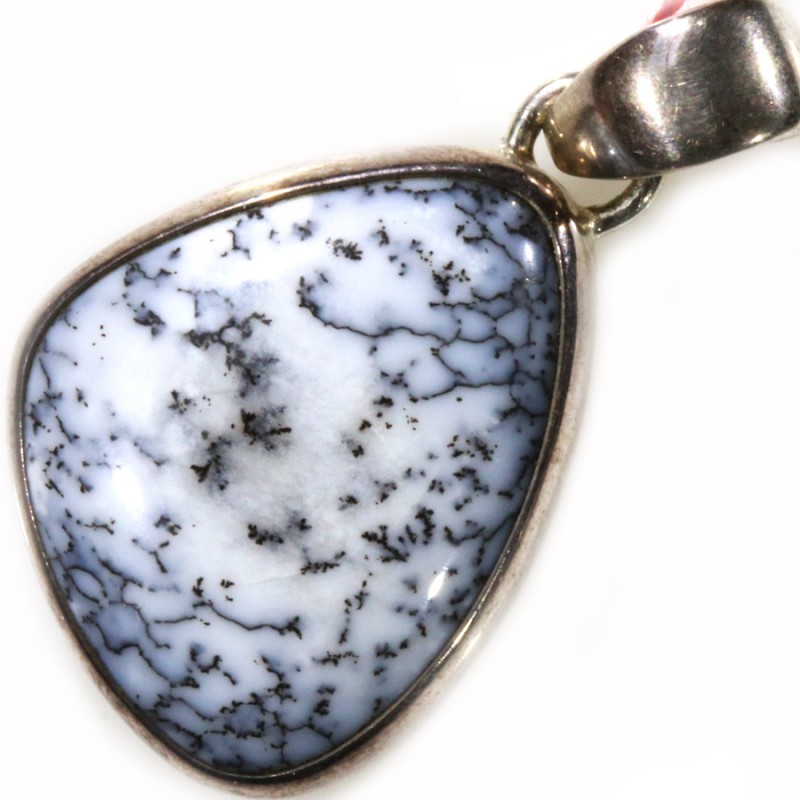
Dendritic Opal a wɔde yɛ aduru
Wɔsan frɛ no “moss opal,” dendritic opal yɛ opal fitaa anaa kɔkɔɔ-biribiri a wɔtaa de di dwuma a nea ɛda nsow ne nea ɛka ho a ɛte sɛ nsɔe a ɛyɛ ahabammono anaa bruu (dendritic). Saa nneɛma a wɔde ka ho yi, a mpɛn pii no manganese anaa dade, yɛ nsusuwso soronko, a nea ɛma yɛkae kwae bi a wohu wɔ “asase so opal” mu no ka ho.
Ɛkame ayɛ sɛ dendritic opals betumi ayɛ nsu ɔha biara mu nkyem 30, na ɛno na ɛkyerɛ sɛ ɛyɛ “aboɔden abo a ɛyɛ mmerɛw.” Saa opal ahorow yi mu dodow no ara fi Australia, Mexico, anaa USA , nanso wubetumi ahu wɔ Amerika Mfinimfini, Asia, ne Russia nyinaa nso.
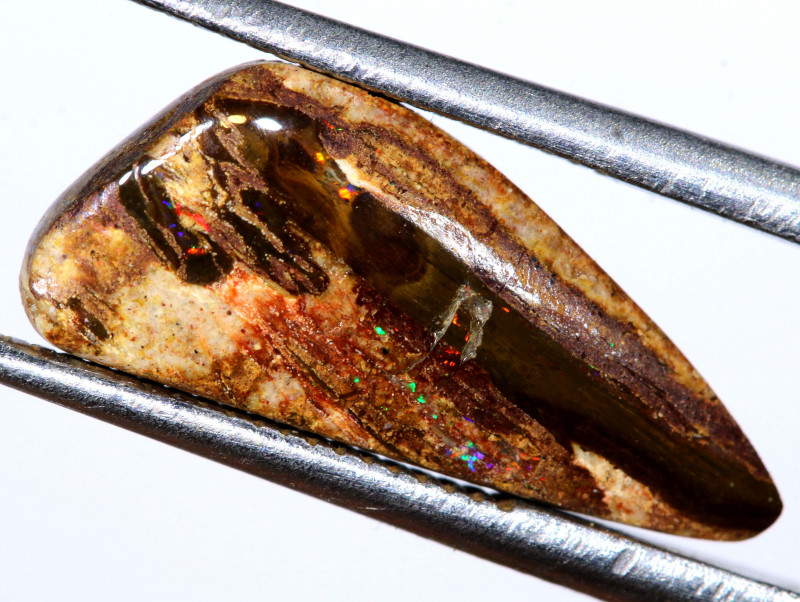
Nnua a Wɔde Opalized ayɛ
Nnua a wɔde opal ayɛ no yɛ dua bi a wɔayɛ no abo a opal wom. Nnua a ayɛ abo yɛ nnua anaa afifide a wɔatutu fam ayɛ a wɔde abo asi afifide no fã bi ananmu, wɔ eyi mu no, opal!
Saa asase so nneɛma a ɛyɛ fɛ yi ba bere a silica nsu kora nnua ntini a wɔasie so no. Ɛhe na abɔde mu adeyɛ yi kɔ? Nnua a wɔde opalized ayɛ no taa ba wɔ kwae a nsõ akata so mu. Nneɛma a wɔde asie a agye din wɔ USA, Indonesia, Russia, Mexico, ne Brazil.
Bere a yɛrefi nneɛma a wɔaka abom a wɔayɛ wɔ abɔde mu no ho no, momma yɛnhwɛ sɛnea nnipa de opal ne nneɛma afoforo bom bio.
Opals a Wɔabom ayɛ
Opal dodow no ara yɛ nneɛma a ɛyɛ den, a ɛyɛ 100% opal. Sɛ nhwɛso no, abɔde mu opals a wɔde nneɛma a ɛnyɛ opal afra no nyɛ opal solids. Nanso, nsonsonoe a ɛda nsow kɛse ne opal a ɛyɛ den ne nea wɔabom ayɛ ntam . Wɔn a wɔyɛ agude ayɛ nsakrae wɔ opal a wɔabom anaasɛ “wɔaboaboa ano” mu na nea ɛka ho ne doublet, triplet, ne mosaic/chip opal. Dɛn nti na tweak nhwɛsode a ɛte saa a mfomso biara nni ho wɔ abɔde mu? Opal a wɔabom ayɛ no ma adetɔfo nya bo a ne bo nyɛ den, na ɛma ɛyɛ ade pa a wɔde besi opal ankasa ananmu.
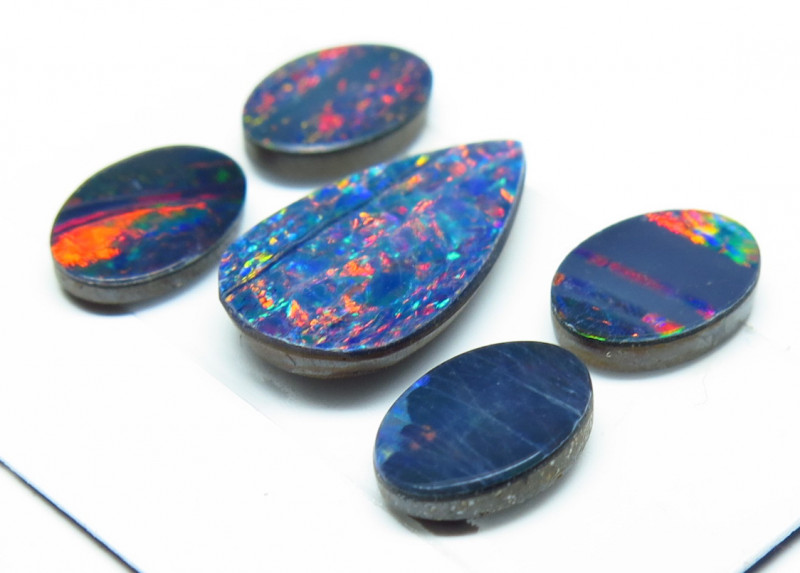
Doublet Opals a wɔde yɛ adwuma
Doublet opals yɛ opals a wɔabom ayɛ a wɔde opal a ɛsom bo a wɔde gluu abɔ ne nnyinaso so. Ebia nea wɔde gyina so no yɛ dade abo a wɔde besuasua boulder opal, aboɔden abo foforo, anaa plastic. Mpɛn pii no, wɔde gluu bata opal a ɛyɛ hare a ɛsom bo ho wɔ nnyinaso tuntum bi so ma ayɛ te sɛ opal tuntum a ɛsom bo.
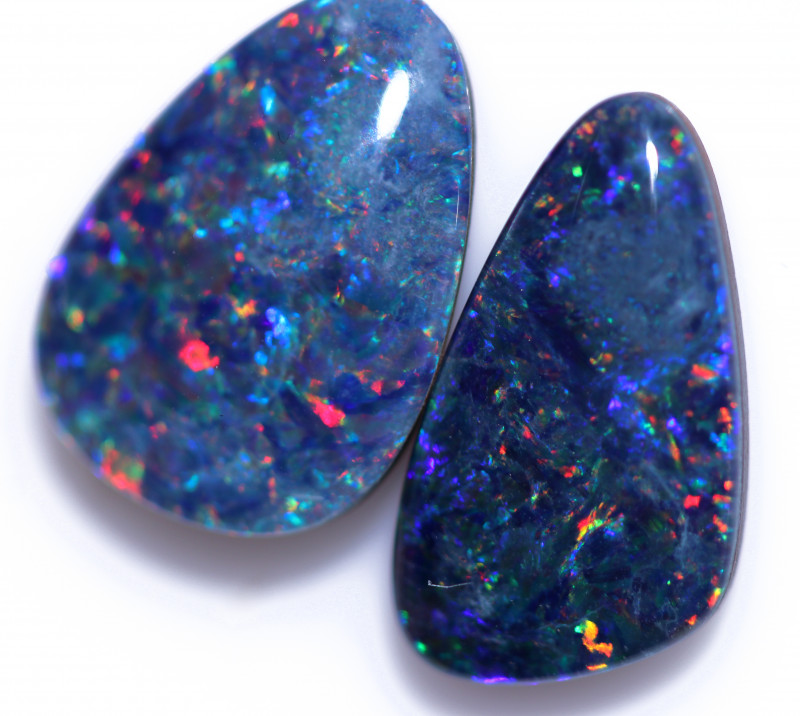
Opals a Wɔde Ayɛ Nneɛma Abiɛsa
Opal abiɛsa no yɛ abien titiriw a wɔde ahwehwɛ dome a ɛbɔ ho ban a wɔde gluu abɔ so. Dome no betumi ayɛ ahwehwɛ, quartz, anaa plastic na ɛma ɔbo no kɔla agodie nso yɛ kɛse. Mpɛn pii no, triplets bo nyɛ den sen doublets efisɛ opal kakraa bi na wɔde di dwuma.

Mosaic & Chip Opals a wɔde yɛ nneɛma
Mosaic ne chip opals yɛ opal abien a wɔabom ayɛ a wɔsan de opal asinasin bom ma ɛyɛ foforo. Wɔ mosaic opals , mu no, wɔde gluu gu ade nketenkete a ɛyɛ tratraa anaasɛ ɛyɛ nwonwa so te sɛ ahwehwɛ a wɔde ayɛ nneɛma wɔ nnyinaso a ɛyɛ tumm so. Wɔ chip opals ho no, wɔde resin fra opal asinasin no na wɔde gu mu ma ɛyɛ den ma ɛbɛyɛ sɛnea wɔpɛ.
Ansa na agudeyɛfo betumi aboaboa opal ahorow a wɔabom ayɛ ano no, ɛsɛ sɛ wɔn a wotu abo no hwehwɛ abo no. Esiane sɛ opal ahorow pii wɔ hɔ nti, ɛhe na wohu opal ahorow wɔ wiase?
Asase ho nneɛma ne asase a ɛsono emu biara kɛse wɔ ɔmantam biara mu no ne nkɛntɛnso titiriw a ɛwɔ opal su so. Asase, wim tebea, ne aboɔden abo a ɛyɛ opal no gu ahorow wɔ wiase nyinaa, enti momma yɛnkɔ wiase nyinaa akwantu!
Opals Sɛnea Fibea
Opal a wotu wɔ wiase nyinaa no taa yɛ nea ɛyɛ opal pɔtee bi ho adwuma titiriw. Bra bere a yɛretu kwan wɔ wiase opal a wotu mu akɔsua wɔn nneɛma titiriw no!
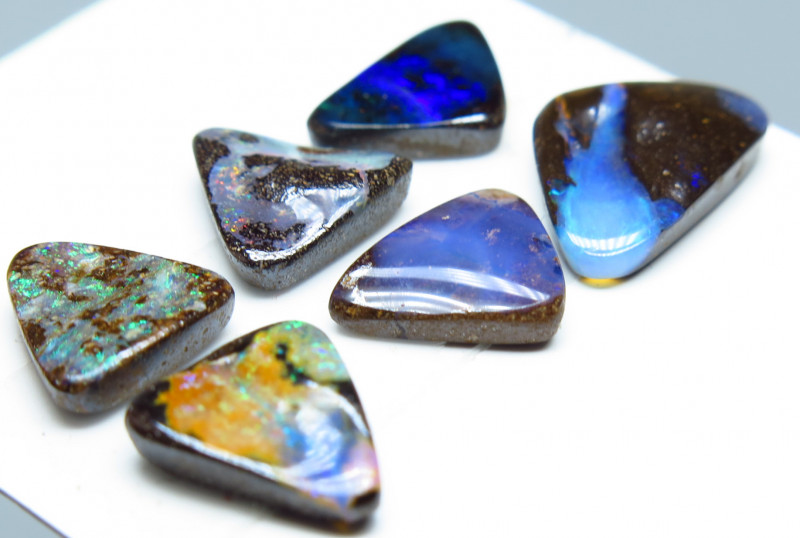
Australiafo Opals a Wɔde Di Dwuma
Ɛnyɛ ahintasɛm sɛ Australia ne ɔman a ɛde opals ma sen biara wɔ wiase. Ɛte saa efisɛ Australia wɔ mmeae ahorow bi a ɛho hia a wotu fagude , a wonim emu biara wɔ Australia opal ahorow ahorow :
Andamooka : Wonim no sɛ ɛyɛ opal a ɛhyerɛn a wɔfrɛ no crystal seam.
Coober Pedy : Ɔno titiriw a ɔyɛ opal fitaa.
Lightning Ridge : Opal a ɛyɛ kɛse sen biara wɔ ne bo mu na wonim no sɛ ɛyɛ opal tuntum a ɛyɛ papa.
Queensland: Ɛwɔ Koroit ne Yowah opal mfuw ne mmeae a wotu fam a ɛkame ayɛ sɛ ɛma wiase nyinaa abotan so opal nyinaa.
Tintenbar : Ɛyɛ ogya bepɔw mu jelly opal tuntum.
White Cliffs Opal : Wonim no sɛ ɛyɛ opal fitaa ne nea ɛsom bo a ɛyɛ seam, ne ananse nnompe a wɔayɛ no opalized.
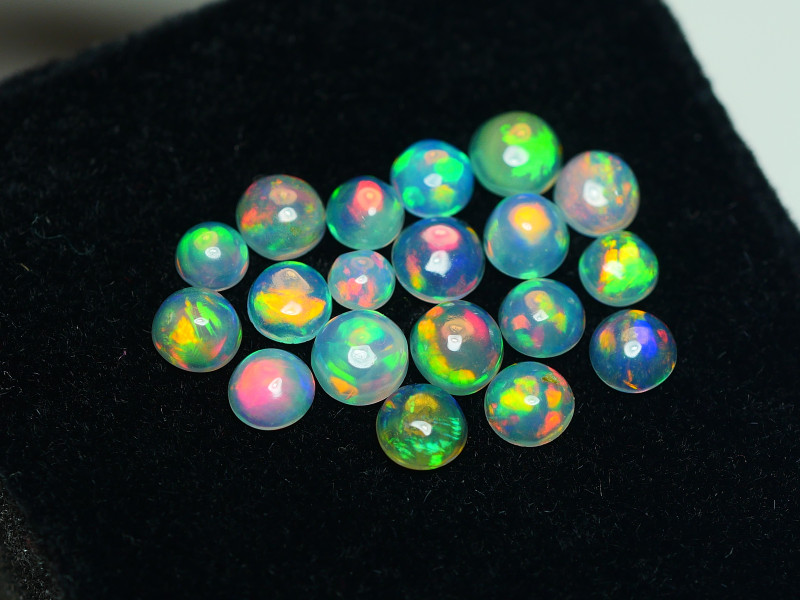
Afrikafo Opal ahorow
Wɔ nnansa yi mfe du du mu no, opal akorae pii a wɔahu wɔ Ethiopia no ama Afrika ayɛ beae titiriw wɔ opal asase mfonini no so.
Ethiopian Opal : Wonim no sɛ hydrophane opals a ɛwɔ play-of-color a ɛda adi pefee ne opal tuntum anaa fitaa a ɛsom bo.
Tanzania Opal : Ɛyɛ opal a wɔkamfo no sen biara.
Madagascar Opal : Nnansa yi ara, wohuu pyrophane opal ne Girasol ogya opal.
Kenya Opal : Wonim no sɛ ɛyɛ opal nkae a akyɛ sen biara ne opal a wɔtaa de ngodua ahabammono.
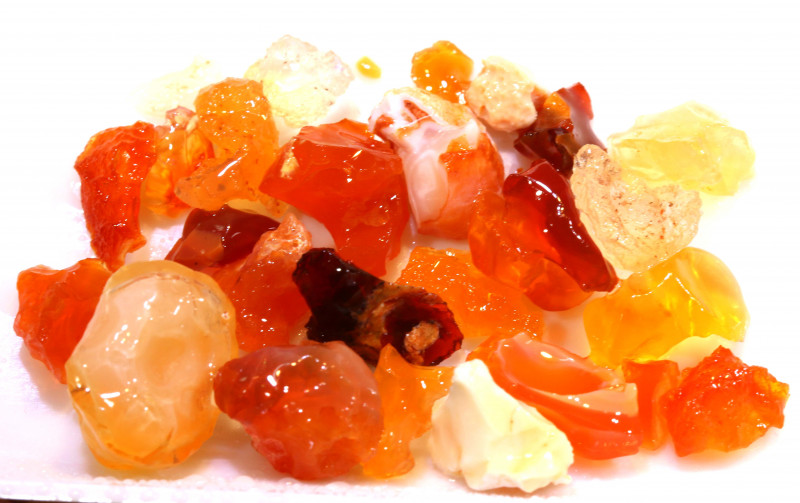
Amerika Mfinimfini & Kesee Fam Opal
Mexico Opal : Wonim no kɛse sɛ ogya opal, nanso Mexico nso yɛ madera opal, contra luz opal, cantera boulder opal, ne wiase no mu nsu opal a eye sen biara no bi.
Brazilian Opal : Wonim no sɛ crystal opal a pastel kɔla a ɛhyerɛn na nsu a ɛwɔ mu no sua.
Peruvian Opal : Wonim no sɛ Peruvian opal bruu anaa pink, a ɛno nso yɛ ɔman no ɔman ɔbo.
Honduras Opal : Wogye tom sɛ ɛkura opal a wotu a akyɛ sen biara wɔ wiase na ɛyɛ abotan ne matrix opal soronko.
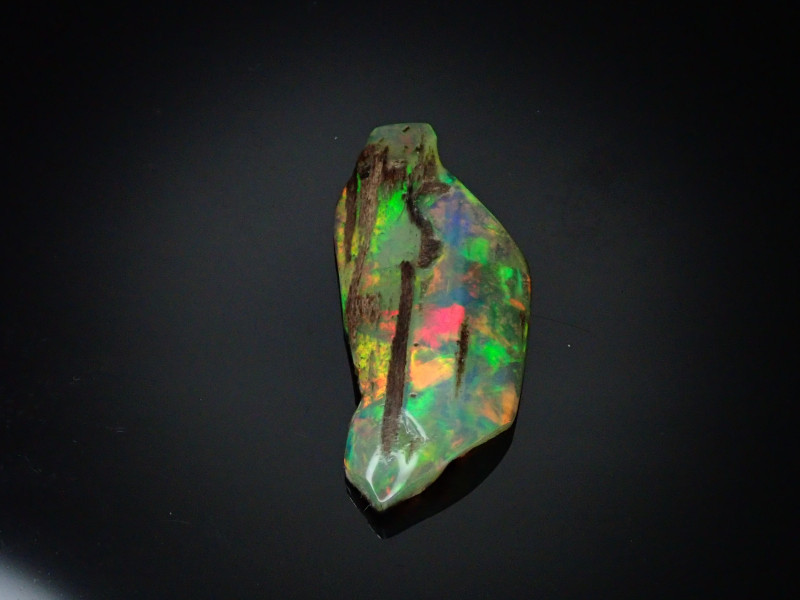
Mmeae Afoforo
Indonesia Opals : Wonim no sɛ ɛyɛ abɔde mu opalite ne nnua a wɔde opalized ayɛ.
Amerika Opals : Dodow no ara fi Idaho , Utah , ne Virgin Valley , Amerikafo ahorow a ɛda nsow ne Owyhee opals, “Thunderegg” opals, nyankontɔn opals, dendritic opals, nnua a wɔde opalized ayɛ, hyalite, banded opals, Louisiana sand opals, ne Utah bacon opals.
Slovakia (anaa Hungary) Opals : Opal fitaa a ɛsom bo soronko a emu kɔla yɛ bruu ne borɔdɔma a ɛhyerɛn.
Opal Ahorow Afoforo
Opal ahorow bi nhyɛ kuw bi mu fɛfɛɛfɛ, nanso ɛnsɛ sɛ wobu ani gu so!
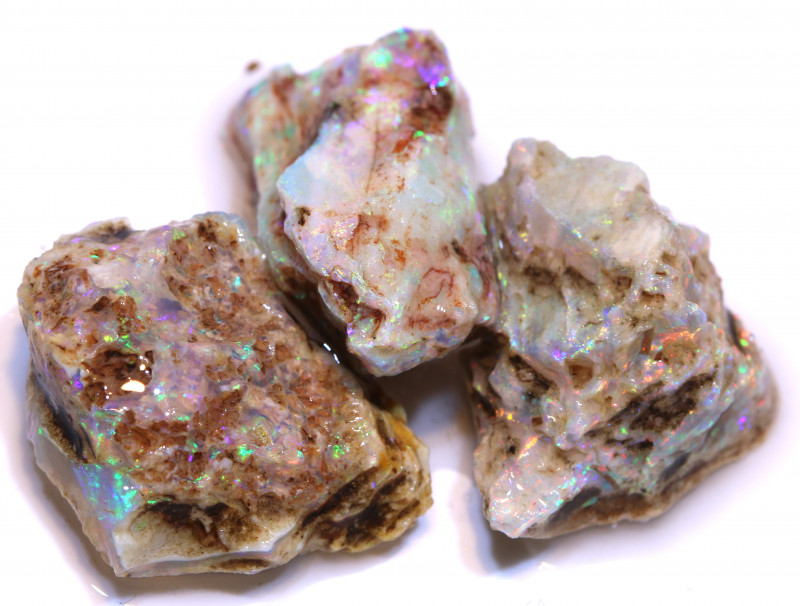
Nnompe a Wɔayɛ no Opalized
Te sɛ Jello nkuku no, silica solution hyɛ nnompe a wɔagyaw wɔ abotan mu no ma na ɛyɛ den ma ɛbɛyɛ opalized fossil ! Saa opal ahorow yi betumi ayɛ mmoa ti nhwi, abon , ananse, ne squid a adi mfe ɔpepem 100 mpo a wɔfrɛ no opalized belemnite . Bere a wohu dodow no ara wɔ Australia no, wɔn a wotu fam no ahu nnompe a wɔde opalized ayɛ wɔ USA, Hungary, ne Indonesia.
Dɛn ne opal a ne bo yɛ den sen biara? Gye di anaasɛ nnye nni, opalized fossil! Wonim Virgin Rainbow sɛ opal a ne bo yɛ den sen biara wɔ wiase no mu biako, sɛ ɛnyɛ nea ne bo yɛ den sen biara a, ɛboro dɔla ɔpepem biako. Ɛyɛ opalized fossil ankasa a ɛyɛ cephalopod bi a ayera a wɔfrɛ no belemnida.

Hyalite a ɔyɛ ɔkyerɛwfo
Hyalite yɛ opal soronko bi a wɔfrɛ no opal-AN, opal a enni nsɛso a ne nhyehyɛe te sɛ ntama te sɛ ahwehwɛ. Saa opal ahorow a wɔtaa yɛ a enni kɔla, kɔkɔɔ a ɛyɛ mmerɛw anaa ahabammono yi nni silica kurukuruwa na ɛrenna play-of-color adi gye sɛ ɛwɔ nneɛma a ɛka ho.
Ade a ɛda nsow kɛse wɔ Hyalite mu ne green fluorescence a uranium a ɛwɔ mu no de ba. Hann a ano yɛ den no da adi wɔ UV hann anaa owia hann tẽẽ mu.
Opals a Wɔde Nneɛma Ayɛ
Nsɛmfua “synthetic,” “simulant,” ne “mitation,” betumi ama adetɔfo adwene atu afra. Wɔn nyinaa kyerɛ opal a nnipa ayɛ, nanso opal a wɔyɛ no sɛnea ɛte no wɔ nnuru a ɛwɔ abɔde mu opal ahorow no ara pɛ, bere a opal a wɔyɛ no sɛnea ɛte no ara te sɛ nea ɛte saa ara.
Wɔ aboɔden abo ho nimdeɛ mu no, “synthetic” kyerɛ opals a wɔyɛ no sɛnea ɛte no katee. Ade biako a ɛka ho ne opalite a wɔayɛ, ahwehwɛ a wɔde ayɛ ahwehwɛ a ɛyɛ opalescent a nnipa ayɛ.
Opal ahorow a wɔde ayɛ a wɔtaa yɛ ne opal tuntum anaa fitaa, nanso ahorow ahorow a wɔyɛ no sɛnea ɛte ne nea wosuasua aba:
Sterling Opal (Monarch Opal) : Synthetic opal a wɔde baeɛ wɔ afe 2016 mu a ɛwɔ kɔla ahodoɔ ne tuntum, linear nsusuiɛ a ɛte sɛ potch inclusions.
Aurora Opal : Opal a wɔayɛ no fã bi a wɔde silica ne resin ayɛ, a ɛwɔ nipadua kɔla ahorow ason na ɛda nsusuwso a ɛyɛ soronko a ɛkyinkyin adi.
Dragon’s Breath Opal : Opal a wɔasuasua a ɛwɔ opalescence nanso enni kɔla a wɔde di agoru, a wɔde Czechoslovakia ahwehwɛ na ɛyɛe na ɛte sɛ ruby-red nanso ɛdannan kɔ bruu ne kɔkɔɔ bere a wɔadan no.

Opal Bɛn na Ɛyɛ Wo Su?
Na ɛno ka ade biara a ɛwɔ opal ahorow a wɔahyehyɛ a edi mũ yi so! Seesei a wunim opal ahorow ne nea ɛkyerɛ nyinaa no, dɛn na w’ani gye ho paa? Sɛ wuntumi nsi gyinae a, hwehwɛ opal ahorow ɔhaha pii a ɛwɔ hɔ no mu na hwehwɛ nea ɛfata wo!
Hu opal a w’ani gye ho paa nnɛ!
搜尋Opal Encyclopedia
相關拍賣
相關文章
Boulder Opal yɛ opal a ne bo nyɛ den a ɛsom bo wɔ gua so no mu biako. Sua pii fa opal soronko yi ho na hwehwɛ abo a ɛyɛ fɛ a yɛwɔ a yɛtɔn no mu.
29th May 2019
Esiane sɛ Wayne ne Estella Sedawie ani gye opals ho nti, wɔde Opal Plus sii hɔ bɛboro mfe 14 a atwam ni na wɔahu sɛ intanɛt yɛ adwinnade a ɛsom bo. Ɛhɔ na adwumakuw no amanaman ntam nkitahodi dodow no ara kɔ so.
17th Oct 2018
最新的文章
Black opals ne opal ahorow a wɔhwehwɛ sen biara, na ne nnyinaso a emu dɔ ma nyankontɔn a ɛyɛ hann wɔ soro. Hu sɛnea wɔde opal tuntum di dwuma, ne su, abakɔsɛm, ne bo a ɛsom!
7th Dec 2025
Hu sɛnea wɔde opal ahorow hyehyɛ mu ne nneɛma a ɛka ne bo. Efi kɔla ne hann so kosi nea wɔatwa ne nea efi mu ba so, sua sɛnea wɔbu opal ahorow biara bo - a nhwɛso ne bo ahorow.
19th Jul 2023
Bra akwantuo mu na sua opals ayaresa tumi ho asɛm firi yɛn ahɔhoɔ kyerɛwfoɔ Vivien Schapera a ɔfiri Crystal Healing Techniques hɔ!
20th May 2023
文章類別
All there is to know about Opals including Black Opals, Ethiopian Opals & Boulder Opal
14文章
Check out our fascinating information and articles on all things amazing in the Opal world
41文章








